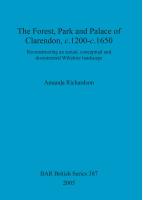Description
BOOK DESCRIPTIONThe main argument of this thesis is that the landscape and locality of Clarendon Forest and Park (some 6 km east of Salisbury, Wiltshire, England) were strongly influenced by the presence (or, later, absence) of Clarendon Palace, which fell into decay inthe late fifteenth century. The first sure evidence of a royal residence at Clarendon dates from the reign of Henry I (1100-1135), although the site may well have Saxon connections. A primary aim of this work is to restore the wider conceptual landscape by considering the forest alongside the relict landscape of the park, and it is argued throughout that, because medieval forests are archaeologically elusive, the best way to achieve this is through an intensive documentary methodology. Attention is drawn throughout to the capacity of documents to illustrate how estates were managed over time. The argument, representing an unprecedented systematic study of manuscript sources for Clarendon Park and Forest held at central and regional record offices, is supported by references to printed primary sources. It has resulted in the compilation of a main computer database listing over 800 relevant documents held at the Public Record Office alone, from which those that might prove most useful were selected and transcribed. The transcriptions, arranged by subject, form several substantial and searchable electronic databases facilitating cross-checking and comparison. The written sources themselves have informed the structure of the work and help to illustrate that this unique landscape and locality was indeed profoundly influenced by the existence of a royal park and palace at its centre.Nevertheless, what has emerged strongly in the course of the study are the myriad ways in which the forest, in turn, shaped the 'lifecycle' of the palace.











